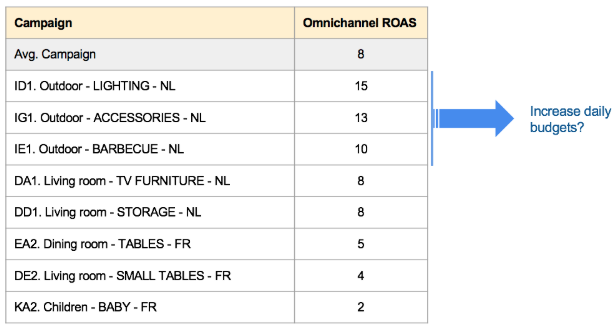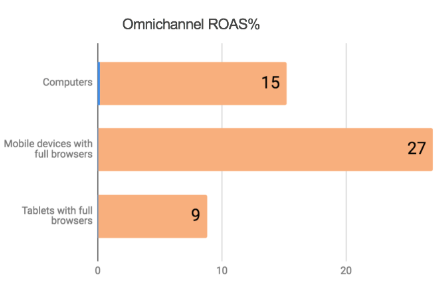According to recent Google figures e-commerce is growing up to 3% every year within the retail industry. Despite this growth we still notice a paradox: in store traffic remains the main objective & KPI of the average retailer. This is all driven by the fact that 80% of retail sales still happen offline. On the other side we cannot forget that 60% of the Belgian retail sales are currently digitally influenced, meaning that these sales were preceded by online research that led the user to an advertising touchpoint. Google expects this influence to reach nearly all purchases by 2022-25.
This proves that consumers are acting more and more omni-channel. About 75% of the shoppers perform research online before making an in-store purchase. Most of them even spend more time online, preparing for the purchase, than they spend time in the store itself. We can definitely state that mobile had a big impact in making the in-store experience grow more efficient.
Store Sales & Visits
Taking this information into account it becomes very important to have an idea of your advertising effectiveness on your customers offline behaviour. Both Google and Facebook offer a solution for this: Store Visits and Store Sales conversions. In short:
- Store Visits have the objective of linking the user who clicked/saw an ad and then went in a brick-and-mortar shop. Store visits is a measure of the number of visits in the shops and not a measure of the revenue generated in-store.
- Store Sales (according to Google) or offline conversions (according to Facebook) have the objective of linking the user who clicked/saw an ad and then made a transaction in a shop. The big difference with store visits lies in the fact that it looks at transaction data.
To have a better view on both solutions and how they work, I recommend to read this article on Store Visits & Offline Conversions written by my colleague.
Omni-channel measurement @IKEA
To show the practical impact of this feature we decided to start a case study for our client IKEA. They are the perfect fit as they recently launched their e-commerce service in Belgium, while their stores remain by far the number 1 converting touchpoint. Stores Sales & Visits are tools that helped us to gauge the impact of our channels both online and offline. It allows us to position our digital marketing channels towards delivering the highest value for their business as a whole.
In short the objective for IKEA is to be ‘the go to place, both offline and online’. It’s finding the perfect balance between lifting off a successful e-commerce strategy while maintaining the popular stores as the business’ keystone. To make this strategy effective omni-channel ROAS need to be calculated in order to see the overall performance of the campaigns. The online revenue is easily taken from the Advertising platform, in this example Google Adwords. Measuring the offline revenue was a little more tricky. Therefore we had to enable Store Visits in our account. This solution links Adwords to the Google My Business account of IKEA in order to know the exact store locations.
At the moment of writing Store Sales, the main metric needed for the ROAS calculation, was not implemented yet. We agreed on making an extrapolation of the offline revenue by using the simple formula below:
- Offline Revenue= #Store Visits * In-store conversion rate * Avg Order value
No quantum physics here. We take the number of store visits of a certain campaign and multiply it with the in-store conversion rate, meaning the average percentage of people that visit the store and do a transaction. At IKEA this number is quite high. Subsequently we multiply with the average order value of an IKEA customer to get the estimated revenue.
- Omni-channel Revenue= Offline Revenue + Online Revenue
- Omni-channel ROAS= Omni-channel Revenue / Marketing investment
We now have a fairly reliable way of calculating Omni-channel ROAS that can be used within our accounts. In Adwords we made a Custom Metric based on this formula. Thanks to this metric we are able to shift our budgets towards the campaigns that yield the highest returns. Find an example with fictional data below:

On top of this we learned not to underestimate the power of mobile. Once a retail company starts an e-commerce service, they are often distracted by the better results on desktop. It is true that for most clients we see better online sales on desktop. This case showed us nevertheless that 53% of store visits were directly related to mobile searches. Taken into account that for IKEA the offline sales are still stronger than the e-commerce sales (as the service is still very new), we can boldly state that mobile had a bigger impact on revenue than desktop, which came in as a surprise!

Based on these new insights we decided to increase our mobile bids. We will only put desktop forward in case we have a pure online sales objective.
Conclusion
Omni-channel measurement is something that every retailer with both physical and online stores should be doing. It enables you to see the complete picture which will result in better decision making and higher revenues. Implementing Store Visits on your performance accounts (start with Search & Shopping) is an easy step. Store Sales is more tricky as you need to find a way to connect with your data warehouse, but will be very rewarding as it gives the most correct view. As always we challenge you to keep up with the current technology and use it as a competitive advantage. Don’t miss this train.
